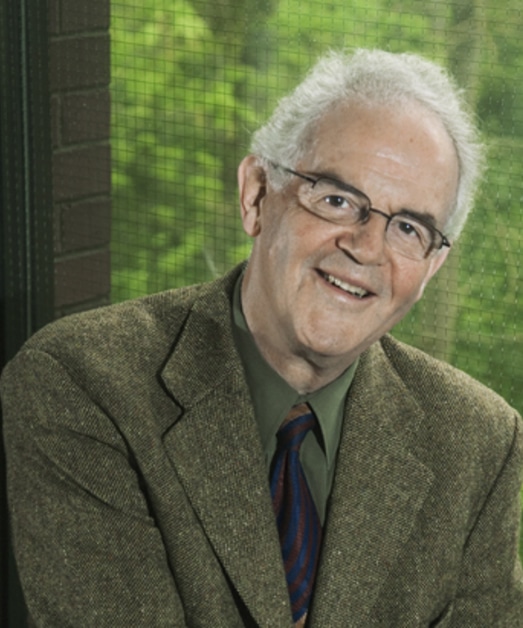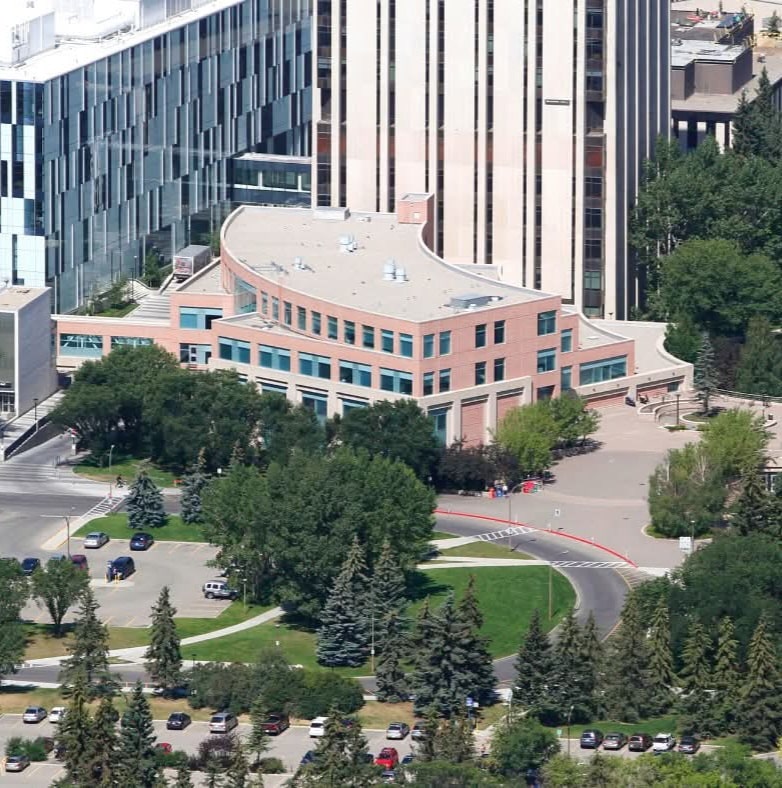By Stacy F. Kaufeld, M.A.
Previous posts in LASA’s “City Builders” series have focused on individuals and their contributions to the city of Calgary over the last 150 years. The following post – in two parts – will examine the Faculty of Law at the University of Calgary through the recollections of its deans.
Part I will consider the roles of John McLaren and Ian Holloway and their strong beliefs in the teaching and researching of Canada’s legal history as part of legal education. Part II will reflect on prominent female faculty, including two deans who went on to careers on the bench.
It is common to believe that until the Fall of 1976 the only law school in province was in Edmonton at the University of Alberta. However, this is not entirely accurate. There was, in fact, a small – twelve students, two faculty, and one Dean – law school at a private post-secondary institution, Calgary College, that opened its doors in 1913.[1] Because of the outbreak of World War I, the students who did not volunteer in Europe continued their studies at the University of Alberta, and the short-lived Faculty closed its doors in 1914.
For the next sixty-two years the University of Alberta was the only law school in the province. This changed when, after years of lobbying, the Ministry of Advanced Education in September 1974 approved the opening of a law school at the University of Calgary. In 1975, John McLaren took became the Faculty’s first dean and remained in that role until 1984.[2]
Along with a faculty of nine members and one librarian, he welcomed the inaugural class of sixty students to the top two floors of the Biological Sciences building. The Faculty nearly doubled in the second year to 115 students and fourteen faculty, expanding to 170 students and eighteen faculty by 1978.[3]
John McLaren
John McLaren was born and educated in the United Kingdom. He taught law at the University of Saskatchewan and the University of Windsor, where he was also dean, before taking the offer to set up Calgary’s law school. He recalls the great involvement and support from the local bar who sat on advisory committees, discussed the curriculum, and even wanted to teach at the school. He remembered a conversation with the Honourable Herb Laycraft, who said to McLaren, “John, one thing I want to impress upon you: you go with your vision. Don’t let anybody, you know, dictate to you – particularly the bar.”[4]

The priority in those early days was, of course, teaching and getting the law program up and running. Based on input from the local bar in downtown Calgary, there was a need for a resources law section that resulted in the establishment of the Canadian Institute of Resources Law. Faculty were encouraged to turn their teaching into research putting it in the broader political, social, and economic context, and use that research in the classroom.[5]
By the 1970s, in Canada, it became clear that legal history should be researched and taught across the country. As law is fundamental to society, it was important for legal history to be contextualized within the wider Canadian experience.[6] In 1973, legal scholar R.C.B. Risk published “A Prospectus for Canadian Legal History” in the Dalhousie Law Journal. Considering the absence of legal history in Canada, Risk’s argues “our understanding of history cannot be complete without some understanding of its legal elements.”[7]
Having a deep interest in history, which dates to his days at law school where his constitutional law teacher was also an historian, McLaren advocated for an interdisciplinary opportunity between law and history to teach an optional course on Canadian legal history. For several years, Louis Knafla from the Department of History and Chris Levy from the Faculty of Law successfully co-taught this popular class. McLaren, in his interview, suggested that if it had not been for the lack of interest from the Faculty of Social Science, they wanted to hire a major English legal historian.[8]
McLaren, along with Knafla and Roderick Macleod at the University of Alberta, helped establish the Alberta Legal History Project. The project began after it was discovered that the government was planning to destroy court records that included many of the most important and noteworthy case files in the province. With support from the Alberta Law Foundation, the universities in Calgary and Edmonton, as well as Alberta Courts, the project aimed to preserve courthouse records as a valuable primary source for researchers studying the legal history of the Northwest Territories and Alberta. With an inventory of the principle legal records for the federal and provincial courts until 1980 they also helped established a retention and disposition schedule the future of the province’s court records.
McLaren was a prolific author of legal history. He published numerous articles and books on topics dealing with comparative colonial law, religion, and racism in the context of legal history. In 1994, he published an article in the Alberta Law Review that examined the Alberta contribution to Canadian legal history. He positioned the importance of legal history as a sub-discipline of Canadian history and argues for a greater inclusion of Canada’s legal history. He concludes that “Albertans have been at the forefront of the teaching and research of Canadian legal history since the mid-1960s” because of Horace Harvey, Wilbur Bowker, Knafla, and Macleod.[9]
McLaren stepped down as professor and dean of the University of Calgary, Faculty of Law in 1984. In 1987, he became the Landsdowne Professor of Law at the University of Victoria where he remained until his retirement in 2006.
Ian Holloway
Ian Holloway, dean at the Faculty of Law at the University of Calgary from 2011 to until his recent retirement in 2024, came to appreciate the significance of legal history for lawyers in a more circuitous manner then McLaren.
Armed with a Bachelor of Science degree in microbiology, he entered law school at Dalhousie with a significantly different background than many of his fellow students coming from history and political science. While articling at a historic Halifax law firm he overheard two partners discussing the importance of A.V. Dicey, author of the Introduction to the Study of the Law of the Constitution and recognized that his legal education failed to provide him with the historical context needed to be an effective lawyer.[10]

Following law school, he enrolled at the Australian National University where he completed a PhD on legal history that focused on the doctrine of natural justice. Holloway thought that understanding first principles historically would help him better represent future clients. He published a book entitled A Study of Common Law Constitutionalism which he reasoned was a history of the root of legal principles for understanding the rule of law.[11]
Based on his own experience, when Holloway was dean at several law schools across Canada, including Calgary, he encouraged the inclusion of legal history as an important part of students’ legal education.
Despite his belief in the significance of learning legal history, Holloway admits that its mandatory inclusion as part of law school curriculum is not an easy sell. With all the classes students must take to fulfill their education requirements, there is not much room for a class that covers what is believed to be the unnecessary, albeit interesting, past of the profession. However, Holloway sees things a little differently and claims there are several reasons legal history is important for the contemporary practice of law.
First, it is only through our sense of history that we can understand the contemporary practice of law. The common law, he suggests, is a conservative system of social ordering and is the yardstick to which we measure current conduct. This is especially important in our current age of social outrage, cancel culture, and misinformation and disinformation. Second, he contends that many law students unintentionally believe that 1982 is year zero in the history of law in Canada. Students need to be taught to understand that Canada has a long tradition of freedom and liberty that existed before Patriation and the Charter of Rights and Freedoms.[12]
Third, like the profession itself, the demographics of law school has changed. No longer can law professors take for granted that incoming students have an extensive background in history. In fact, many come to law school having never opened a history book. In addition, international law students may have limited knowledge of Canada’s history, and background on Canada’s legal evolution could be helpful. Fourth, and connected to the third point, law professors have an opportunity to work with this ‘blank slate’ to impress upon students the importance of learning the historical, constitutional, and philosophical meanings behind Canada’s system of law and government.[13]
During his tenure at Calgary, Dean Holloway reformed the curriculum to reintegrate legal history as a compulsory first-year course. It was done with the aim to reintroduce, even introduce, students to origins of the common law system, the roots of parliament, and other foundational questions that are taken for granted as having always been there. Students examine the origins of constitutionalism and even compare Canada’s system with other Commonwealth countries appreciating that Canada’s path to constitutional independence was a gradual process. This journey through legal history is intended to teach first principles and turns students into excellent lawyers.[14]
Deans McLaren and Holloway appreciated the importance of understanding history for the contemporary practice of law. Both individuals recognized that history extends beyond the mere recollection of facts, dates, and anecdotes. They acknowledged that analyzing historical developments and major transformations enables students to understand the complexities inherent in practicing law in today’s world.
[1] The Deans of the University of Calgary, Faculty of Law, “The Faculty of Law, the University of Calgary,” in Just Works: Lawyers in Alberta, 1907-2007 ed. Michael Payne (Toronto: Irwin Law, 2007), pg. 222.
[2] Ibid., pg. 222.
[3] Ibid., pg. 222.
[4] John McLaren, interviewed by David Mittelstadt, Legal Archives Society of Alberta, April 21, 2010. LASA Accession 2010021.
[5] Ibid.
[6] Philip Girard, Jim Phillips, and R. Blake Brown, A History of Law in Canada, Volume One: Beginnings to 1866 (Toronto: University of Toronto Press, 2018), pg. 3.
[7] R.C.B. Risk, “A Prospectus for Canadian Legal History,” Dalhousie Law Journal vol. 1, no. 2 (1973): pg. 227.
[8] McLaren Interview, April 21, 2010.
[9] John McLaren, “Meeting the Challenges of Canadian Legal History: The Albertan Contribution,” Alberta Law Review vol. 32, no. 3 (1994): pg. 425.
[10] Legal Archives Society of Alberta, Annual Report 2022, pg. 16. https://legalarchives.ca/wp-content/uploads/2023/06/Annual-Report_2022.pdf. Accessed November 4, 2025.
[11] Ibid.
[12] Ibid.
[13] Ibid.
[14] Ibid.



